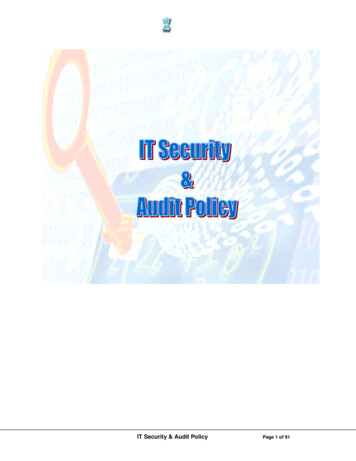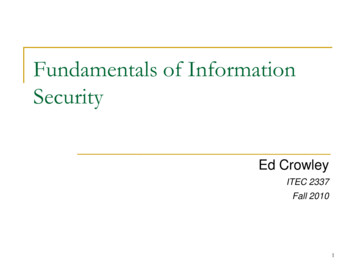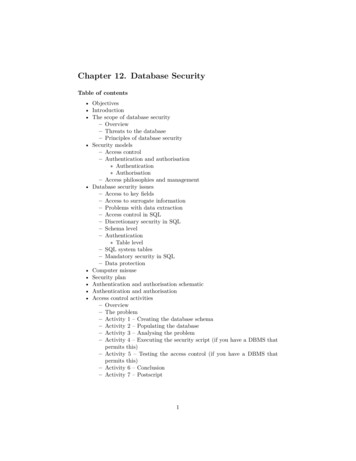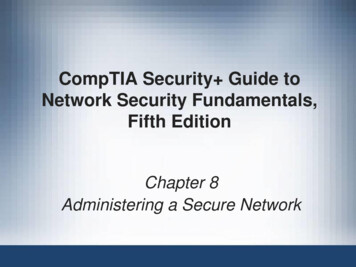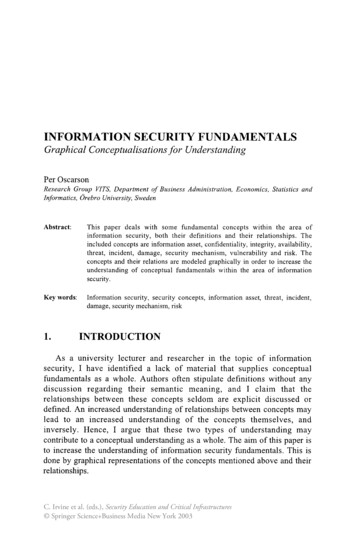
Transcription
INFORMATION SECURITY FUNDAMENTALSGraphical Conceptualisations for UnderstandingPer OscarsonResearch Group VITS. Department of Business Administration. Economics. Statistics andInformatics. Orebro University. SwedenAbstract:This paper deals with some fundamental concepts within the area ofinformation security, both their definitions and their relationships. Theincluded concepts are information asset, confidentiality, integrity, availability,threat, incident, damage, security mechanism, vulnerability and risk. Theconcepts and their relations are modeled graphically in order to increase theunderstanding of conceptual fundamentals within the area of informationsecurity.Key words:Information security, security concepts, information asset, threat, incident,damage, security mechanism, risk1.INTRODUCTIONAs a university lecturer and researcher in the topic of informationsecurity, I have identified a lack of material that supplies conceptualfundamentals as a whole. Authors often stipulate definitions without anydiscussion regarding their semantic meaning, and I claim that therelationships between these concepts seldom are explicit discussed ordefined. An increased understanding of relationships between concepts maylead to an increased understanding of the concepts themselves, andinversely. Hence, I argue that these two types of understanding maycontribute to a conceptual understanding as a whole. The aim of this paper isto increase the understanding of information security fundamentals. This isdone by graphical representations of the concepts mentioned above and theirrelationships.C. Irvine et al. (eds.), Security Education and Critical Infrastructures Springer Science Business Media New York 2003
96Information Security FundamentalsThis paper is based on a licentiate thesis (Oscarson, 2001) that was builtupon theoretical as well as empirical studies. However, the conceptual workhas been continued during the year 2002, and the fundamental concepts andtheir relationships have therefore been further developed. One important partof this work is interaction with students; the graphs have been used whentutoring students' final theses in bachelor and master programs. Theexperiences of that work are good, even if no systematic empirical researchhas been done. During the spring 2003, the graphical conceptualisations areused in a basic distance course in information security. An evaluation of theusefulness of the graphs in that course is currently under design.2.INFORMATION ASSETSThe foundation for security is assets that need to be protected (see e.g.Gollman, 1999). Assets may be people, things created by people or parts ofnature. In the area of information security, the assets are often labelled asinformation assets, and enclose not only the information itself but alsoresources that are in use to facilitate the management of information (e.g.Bjorck, 2001; ISO/IEe 17799,2001), as depicted in Figure 1./',-------------------------------,Information Assets.\Resources - Knowledge and toolsFacilitate themanagement of\,,, Information,-------------------------------, Figure 1. Infonnation assets consist of infonnation as well as resources to facilitate themanagement of infonnationI claim that it is the information that is the primary asset, and IT andother resources are tools to facilitate information management. Resourceshave hence an instrumental value in relation to the information (of course,information may be highly integrated with resources that manage theinformation, e.g. in a database). The term information security expressestherefore a more holistic view than IT-security, which manifests a more
97Per Oscarsontechnical view since technical resources are focused (Oscarson, 2001). As itwill be seen in Figure 2, I define IT as digital tools for managinginformation. A more exhaustive definition of IT is (translated fromOscarson, 2001, p 56):Information technology (IT) is a concept that refers to digital technology,i.e. hard- and software for creating, collecting, processing, storing,transmitting, presenting and duplicating information. The informationmay be in the shape of e.g. sound, text, image or video, and IT meanhence a merging of the traditional areas of computers, telecom andmedia.IT artefacts in the shape of e.g. personal computers, networks, operativesystems and applications constitute thus one of several types of supportingresources for manage information. It is not only IT artefacts to be counted asresources when managing information. Information may be managedmanually, which make humans an important resource. People are alsoindirectly an important resource because that is always people that handletools that manage information. Tools that help humans to manageinformation may be electronic or non-electronic. Moreover, electronic toolsmay be divided into digital and analogue tools. Figure 2 shows a simpleclassification of information-managing resources.Non-electronic tools may be for example pens, papers, staplers and noticeboards while analogue tools are for example over-head devices, papershredders and telephones (which also can be digital). Security mechanisms(safeguards) may also be counted as resources for managing information.Security mechanisms may belong to all of the categories illustrated in Figure2 (more about security mechanisms in section ----------------Resources for manage anualresourcesToolsNonelectronictoolsElectronic toolsAnaloguetoolsFigure 2. A classification of resources for infonnation managementDigitaltools (IT)
98Information Security FundamentalsInformation as an asset in organizations is a wide domain of knowledge,and is not only about information (represented by data) stored in IT-basedinformation systems. A great amount of an organization's information isnon-formalized and is not digitalized or even on print. Information thatseems to be unimportant for one organization may be important to otheractors, e.g. competitors. Some information, e.g. negative publicity, may ariseat the same moment when an incident occurs. For example, the informationthat an information system has been hacked may become very sensitiveinformation at the same moment the incident occurs. Moreover, informationas an asset is not only about information that exists in an organization - it isalso important that an organization can obtain relevant and reliableinformation when necessary.2.1Confidentially, Integrity and AvailabilitySecurity concerning IT and information is normally defined by threeaspects, or goals; confidentiality, integrity and availability (see e.g. Gollman,1999; Harris, 2002; Jonsson, 1995). The concepts can be seen as theobjectives with security regarding IT and information and are often referredto as the 'CIA triad' (Harris, 2002). Definitions of the CIA triad may differdepending on what kind of assets that are focused, e.g. a specificcomputer/IT system, information system or information assets as definedabove. Regarding information assets, the three concepts can be defined asfollows:Confidentiality: Prevention of unauthorized disclosure or use ofinformation assetsIntegrity: Prevention of unauthorized modification of information assetsAvailability: Ensuring of authorized access of information assets whenrequiredThe definitions are influenced by Gollman (1999) and Harris (2002), butare revised in the following way: Gollman and Harris use 'information'and/or 'systems' for the three concepts, while I claim that all three conceptsshould concern both information and resources for managing information,i.e. information assets. The objective is that both information and resourceswill stay confidential, unmodified and available. For example, weaknesses inconfidentiality may be caused both by disclosure of sensitive informationand by unauthorized use of a computer system. Integrity can be seen as aquality characteristic of information assets, while confidentiality andavailability are characteristics of the relations between information assetsand an authorized user (availability) and an unauthorized user(confidentiality), as depicted in Figure 3.
99Per OscarsonAvailability /.UnauthorizeduserIntegrityFigure 3. A graphical description of the CIA triad - Confidentiality, Integrity and Availability(influenced by Jonsson, 1995; Olovsson, 1992)For simplifying reasons, the CIA triad will henceforth in the paper betreated as characteristics of information assets, even if correct definitions intwo cases are characteristics between information assets and users (whichmay be authorized or unauthorized).2.2Threats against Information AssetsInformation assets may be exposed for threats. There are a number ofdefinitions of threat in the field of computers, IT and information. Here are afew examples:' . an indication that an undesirable event may occur' (Parker, 1981),' . any potential danger to information or systems' (Harris, 2002),' . circumstances that have the potential to cause loss or harm' (Pfleeger,1996).If the objective of information security is to reach and maintain the CIAtriad of information assets at a required level, threat is something thatpotentially can impair the CIA triad in the future. Parker (1981) mentions'undesirable events' above (which I label as incident, see next sectionbelow), which I interpret as if confidentiality, integrity or availability will beimpaired. That means that a threat consists of a potential action oroccurrence that may affect the information asset's CIA triad negatively.Actions and occurrences do not happen by themselves, there must be causeslying behind. Harris (2002) calls such underlying causes for threat agents,and it may be actors (humans or organizations), by human made artefacts ornatural phenomena (cf. e.g. Pfleeger, 1996). In my definition of threat Ihence include both actions/occurrences and underlying causes:Threats are potential undesirable actions or occurrences, that performs orcauses by actors, by human created artifacts or natural phenomena andwhich are supposed to impair the CIA triad of current information assets.
100Information Security FundamentalsUsing the definitions discussed so far, we can define the relationsbetween threat agent, threat, the CIA triad and information asset as well (seeFigure 4).Threat Agent (Actor,Artefact or NaturalPhenomenon)Information Assets(Information andresources)Againstn.Lay behind,OfVIs supposedto impair.Threat(Potential Action orOccurrence)The CIA Triad ,,'''',m«"' iBFigure 4. The relations between threat agent, threat, the CIA triad and information assetsHuman threat agents may be intentional or accidental (see e.g. Harris,2002). Terrorism, information warfare, sabotages and intrusions areexamples of intentional threats, while carelessness, mistakes and ignoranceare unintentional threats. Non-human threats, i.e. artefacts and naturalphenomena, may be floods, fires, earthquakes and thunderstorms. Artefactsmay function in undesirable ways, and since humans create artefacts, threatsoften have a combination of underlying threat agents. That is, humans mayconstruct, implement, configure or handle artefacts in inappropriate ordestructive ways, for example people who creates destructive IT -artefacts asviruses and worms.Physical threats are threats that appear in a physical manner, like floods,thefts and fires. Non-physical threats, or logical threats, are often connectedto software as viruses, computer intrusion and user's software mistakes.Such threats will mostly affect non-physical assets, but may affect physicalassets as well.Sometimes there are reasons to expect that actors, artefacts or naturalphenomena that are not yet existing, or not for the moment performingactions or causing occurrences may do so in the future. They can beapprehended as potential threats.
Per Oscarson3.101INCIDENTS AND DAMAGESWhile a threat is an assumption that an undesirable event may occur in afuture, the term incident refers to the actual occurrence of such event. Inother words, a threat may be realized as one or several incidents. A threatmay still exist after a realization, since underlying causes still may havecapabilities to realize the threat several times. The probability for realizationwill however often decrease since people often increase the protectionagainst realized threats. Like threats, an occurred incident may be unknown.Such incidents may be discovered after a while or remain unknown.Incidents that are realized by unknown threats are unexpected incidents.Incidents may lead to consequences. If a consequence affects the CIAtriad of information assets uncontrolled and negatively, it is labelled asdamage. There may be incidents that not impair the CIA triad, for example avirus that infects an information system without causing any damage. Theinfection is still an undesired event that probably happens out of the controlof the system managers.Figure 5 shows the relationships between threat agent, threat, informationasset, the CIA triad, incident and damage (the definitions of threat and assetshave been removed from the illustration to make the graph more simple).ThreatAgent1'--The-cIAT d--'\InformationAsset, - - - - - - -. 111Confidentiality::'--".,.,.--,--.,.,.".,.", .IntegrityThreatIs supposed to impair --------------; ]i i;:::: .Availability--,.,.".,.",.".,.",.".,.",.",.,.,.,. .:11::'--- --------- /MaycauseIncidentDamageImpairsFigure 5. The concepts incident and damage are added to the growing graphA definition of damage may be extracted from the objectives ofinformation security:Damages are uncontrolled impairs of the CIA triad of information assets.
102Information Security FundamentalsPractically, there may be many kinds of damages. Information can bechanged in an uncontrolled and undesirable way, information may disappearor be read by unauthorized persons and information and IT artefacts may beunavailable for authorized persons.4.SECURITY MECHANISMSSecurity mechanisms are something that will improve the CIA triad ofinformation assets, i.e. increase the information security (Oscarson, 2001).The terms protections, countermeasures, controls and safeguards may beused as synonyms to security mechanisms. Security mechanisms can becategorized in several ways. Bases for categorizations may be for exampletheir relation to the CIA triad (Jonsson, 1995; Oscarson, 2001) or what theyconsists of - e.g. hardware, software and policies - (e.g. Pfleeger, 1996).One way is to categorize them based on their functionality in relation to thetime of an incident; security mechanisms can be preventing, averting orrecovering (SIG Security, 1999). Preventing security mechanisms are highlydirected to the threat; to affect threat agents in purpose to reduce the dangerof a threat, or the probability that a threat will be realized to incidents.Examples of preventing security mechanisms are security awareness andlaws. Averting security mechanisms intend to obstruct incidents, e.g. in theshape of firewalls or encryption programs. Recovering (or restoring) securitymechanisms recover already damaged information assets. An example of asecurity mechanism is anti-virus software that repairs infected files.In accordance to the four objects threat, incident, damage and the CIAtriad, there is one link missing in the chain. There are security mechanismsthat reduce damages, as for example fire extinguisher, that either avertincidents nor recover an already damaged information asset; such securitymechanisms are damage reducing. Summing up, a categorization of securitybased on time of an incident consists of four categories: preventing, averting,damage reducing and recovering security mechanisms (see Figure 6).
103Per yMechanismtI0,ThreattItIIntends toreduce.Maylead toIncidenttIIntends toreduceIntends toobstructMay berealizedas anRecoveringSecurityMechanismDamage reducingSecurityMechanism.Intends torecover.ImpairsDamageThe CIATriadTimeFigure 6. Four categories of security mechanisms based on their relation in time to incidentsTwo other categories that closely fit in to this categorization are detective(e.g. Gollman, 1999; Olovsson, 1992) and reporting security mechanisms(Statskontoret, 1997). The reason why they do not can be used in this type ofcategorization is that they may be used in any time in relation to an incident;before, during or after the realization of a threat. Detecting securitymechanisms may be used for discovering/reporting new kinds of threats,detectinglreporting intrusions or intrusion attempts, as well asdetecting/reporting already damaged information assets. Detective securitymechanisms are almost always also reporting; when some threat, incident ordamage has been detected, it may also be reported. That means thatpreventing, averting or recovering security mechanisms may be detectingand/or reporting as well. Additionally, it is important to understand thatspecific security products may have several functionalities, i.e. preventing,averting, damage reducing, recovering, detecting and reporting.The four categories of security mechanisms that are presented in thissection can be connected to the growing conceptual graph and is shown inFigure 7; preventing security mechanisms may affect threat agents, avertingsecurity mechanisms may obstruct incidents, and damage reducingmechanisms may reduce damages. Finally, recovering security mechanismsmay completely or partially restore impaired confidentiality, integrity oravailability of information assets.
Information Security tionAssetThe CIA Triad\ConfidentialityIntegrityIs supposed to amageImpairsIntends toobstructIntends torecoverIntends toreduce,,------ --------------- --------------- --------------- ------',: eReducingIRecovering:IIIII -------------------------------I- - - - - - - - - - - - - - - - - - - - - - - - - IMay exist InVulnerabilityFigure 7. A graphical representation of fundamental concepts and their relationships4.1VulnerabilityVulnerability is absence of security mechanisms, or weaknesses inexisting security mechanisms (see e.g. Harris, 2002; Ozier, 2000).Vulnerability may exist in all of the categories of security mechanisms thatare mentioned in the previous section (see Figure 7), and may be known orunknown.
Per Oscarson5.105RISKRisk is another fundamental concept in the area of security. However, therisk concept is difficult to range in the graph presented above, since risk is aconcept that concerns assessed future conditions; some of the objects in thegraph are changing when it comes to risk assessment, e.g. 'potential damage'instead of 'damage'. Moreover, the graph tends to be too complex if itincludes a large number of concepts and relations. This section presentshence another conceptual graph concerning risk assessment.Risk is someone' s estimation concerning the occurrences of incidents andpotential damages caused by incidents (e.g. Parker, 1981 and Ozier, 2000).Consequently, the concept of risk consists of two parts; the probability or theexpected frequency of that an incident will occur and the potential damagesan incident may cause. This can be expressed in the following equation:R L*PR stands for risk, L is potential loss, and P is probability or expectedfrequency of loss (Parker, 1981). Even if an incident leads to a seriousdamage, there is no risk if the probability or expected frequency is zero, andreverse. This means that R 0 require L 0 and/or P O. In accordance tothe discussion about damages above, the terms damages and loss are usedsynonymously. In the standard ISOJIEC 17799 (2001, P 8), risk (assessment)is defined in a similar way, i.e. it consists of the likelihood of an incident aswell as the potential negative consequences.The risk concept including probability, expected frequency and potentialdamage may be connected graphically to threat, incident, information assetand the CIA triad (see Figure 8). As shown in Figure 8, the risk concept isclosely related to threats, incidents and the CIA triad of information assets.That means that risk assessment must deal with estimation of thosephenomena. However, the risk concept is not connected to securitymechanisms and vulnerabilities in this graph. As discussed previously in thispaper, security mechanisms may intend to affect threat agents, reducethreats, obstruct incident, reduce damages or recover impairs of the CIAtriad of information assets. This means that security mechanisms maydecrease risks by decreasing the probability or the expected frequency of theoccurrences of incidents, or by decreasing damages of occurred incidents.Vulnerabilities in security mechanisms will increase risks.
Information Security nassetPerceivedthreat{The CIA lity:-.,,,--------,,.--.-J :\OfExpectedfrequency11e'l,--------. IIIConceivableincidentProbability\'------------ IPotentialdamageOrAndIs a ofproductIRiskFigure 8. The risk concept in relation to threat, incident, the CIA triad and information assets6.SUMMARYThis paper has introduced some graphical conceptualisations offundamental concepts within the information security area. Conceptualmodelling is based upon linguistic and philosophical perceptions andstandpoints, and is hence heavily dependent on underlying perspectives. Thatmeans that linguistic definitions of concepts, or relations between concepts,never can be regarded as a "universal truth", but may represent a way tostudy a phenomenon or an area. With that in mind, the graphs may be usefulin future research as well as for educational purposes. As mentioned in theintroduction section, an empirical study in form of a course evaluation isplanned. Such study may work as a further grounding, and/or a refining ofthe graphs presented in this paper.
Per Oscarson107Even if my own perspective is business oriented, I believe this conceptualwork is quite generic in the sense that it may be valid even for moretechnical areas of security, and therefore may be useful in more technicaloriented education. However, I believe that the business-oriented perspectivehas some impact on the result, especially the concept of information asset. Inmore technical oriented perspectives, assets often consist of data and systemrather than information and resources for information management (cf. e.g.Jonsson, 1995). My intention is to continue this work in purpose to create aframework regarding actual and perceived information security. This workwill among other things include modelling of concepts in differentconditions of time and if they are referring to actual conditions or subjectiveperceptions. For this work, this paper may serve as one part of a conceptualbase.REFERENCESBjorck F (2001). Security Scandinavian Style - Interpreting the Practice of ManagingInformation Security in Organisations. Licentiate Thesis, Department of Computer andSystems Sciences, Stockholm University/Royal Institute of Technology, StockholmGoHman D (1999). Computer Security. WileyHarris S (2002). CISSP Certification Exam Guide. McGraw-Hill/Osbourne,Jonsson E (1995). A Quantitative Approach to Computer Security from a DependabilityPerspective. Doctoral Dissertation, Department of Computer Engineering, ChalmersUniversity of Technology, GoteborgOlovsson T (1992). A Structured Approach to Computer Security. Technical Report No 122,Department of Computer Engineering, Chalmers University of Technology, GoteborgOscarson P (2001). Informationssakerhet i verksamheter. (Information Security inOrganizations - in Swedish). Licentiate Thesis, Department of Computer and InformationScience, Linkoping UniversityOzier W (2000) Risk Analysis and Assessment, in Information Security Handbook, Tipton HF & Krause M, Auerbach publicationsParker D B (1981). Computer Security Management, Prentice HallPfleeger C P (1996). Security in Computing. Prentice-Hall,SIG Security (1999). Sakerhetsarkitekturer (Security Architectures, in Swedish). SIGSecurity, StudentlitteraturISO/IEC 17799 (2001). Information Technology - Code of Practice for Information SecurityManagement. International Organization for StandardizationStatskontoret (1997). Handbok i IT -sakerhet (IT Security Handbook, in Swedish), TheSwedish Agency for Public Management
98 Information Security Fundamentals Information as an asset in organizations is a wide domain of knowledge, and is not only about information (represented by data) stored in IT-based information systems. A great amount of an organization's information is non-formalized and is not digitalized or even on print. Information thatCited by: 3Publish Year: 2003



